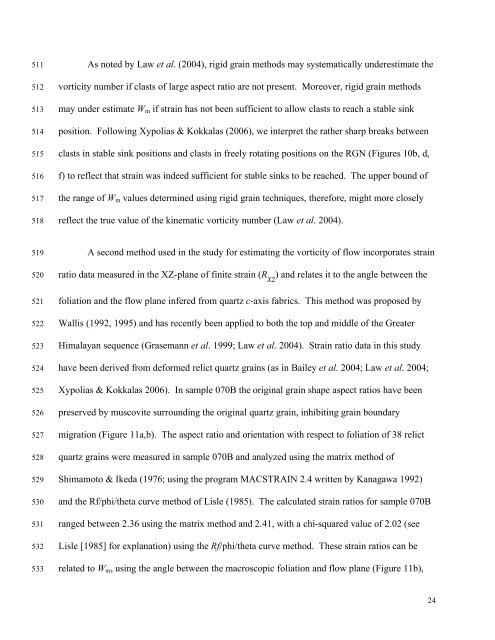Kinematics of the Greater Himalayan sequence, Dhaulagiri Himal ...
Kinematics of the Greater Himalayan sequence, Dhaulagiri Himal ...
Kinematics of the Greater Himalayan sequence, Dhaulagiri Himal ...
You also want an ePaper? Increase the reach of your titles
YUMPU automatically turns print PDFs into web optimized ePapers that Google loves.
511<br />
512<br />
513<br />
514<br />
515<br />
516<br />
517<br />
518<br />
As noted by Law et al. (2004), rigid grain methods may systematically underestimate <strong>the</strong><br />
vorticity number if clasts <strong>of</strong> large aspect ratio are not present. Moreover, rigid grain methods<br />
may under estimate W m if strain has not been sufficient to allow clasts to reach a stable sink<br />
position. Following Xypolias & Kokkalas (2006), we interpret <strong>the</strong> ra<strong>the</strong>r sharp breaks between<br />
clasts in stable sink positions and clasts in freely rotating positions on <strong>the</strong> RGN (Figures 10b, d,<br />
f) to reflect that strain was indeed sufficient for stable sinks to be reached. The upper bound <strong>of</strong><br />
<strong>the</strong> range <strong>of</strong> W m values determined using rigid grain techniques, <strong>the</strong>refore, might more closely<br />
reflect <strong>the</strong> true value <strong>of</strong> <strong>the</strong> kinematic vorticity number (Law et al. 2004).<br />
519<br />
520<br />
521<br />
522<br />
523<br />
524<br />
525<br />
526<br />
527<br />
528<br />
529<br />
530<br />
531<br />
532<br />
533<br />
A second method used in <strong>the</strong> study for estimating <strong>the</strong> vorticity <strong>of</strong> flow incorporates strain<br />
ratio data measured in <strong>the</strong> XZ-plane <strong>of</strong> finite strain (R xz<br />
) and relates it to <strong>the</strong> angle between <strong>the</strong><br />
foliation and <strong>the</strong> flow plane infered from quartz c-axis fabrics. This method was proposed by<br />
Wallis (1992, 1995) and has recently been applied to both <strong>the</strong> top and middle <strong>of</strong> <strong>the</strong> <strong>Greater</strong><br />
<strong><strong>Himal</strong>ayan</strong> <strong>sequence</strong> (Grasemann et al. 1999; Law et al. 2004). Strain ratio data in this study<br />
have been derived from deformed relict quartz grains (as in Bailey et al. 2004; Law et al. 2004;<br />
Xypolias & Kokkalas 2006). In sample 070B <strong>the</strong> original grain shape aspect ratios have been<br />
preserved by muscovite surrounding <strong>the</strong> original quartz grain, inhibiting grain boundary<br />
migration (Figure 11a,b). The aspect ratio and orientation with respect to foliation <strong>of</strong> 38 relict<br />
quartz grains were measured in sample 070B and analyzed using <strong>the</strong> matrix method <strong>of</strong><br />
Shimamoto & Ikeda (1976; using <strong>the</strong> program MACSTRAIN 2.4 written by Kanagawa 1992)<br />
and <strong>the</strong> Rf/phi/<strong>the</strong>ta curve method <strong>of</strong> Lisle (1985). The calculated strain ratios for sample 070B<br />
ranged between 2.36 using <strong>the</strong> matrix method and 2.41, with a chi-squared value <strong>of</strong> 2.02 (see<br />
Lisle [1985] for explanation) using <strong>the</strong> Rf/phi/<strong>the</strong>ta curve method. These strain ratios can be<br />
related to W m , using <strong>the</strong> angle between <strong>the</strong> macroscopic foliation and flow plane (Figure 11b),<br />
24

















